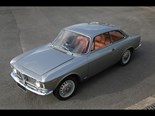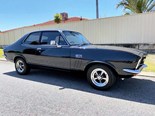Charger brakes, underbonnet fluff and Lexus dash gloop - Morley's Workshop 439



|
Have another look at that 'wrong' part, old rubber, electronic failures and Commodore mysteries
MORLEY'S WORKSHOP
Just when I thought I’d seen it all…along comes a weird-burger with the lot. It arrived in the form of a VH Charger that I’d just started to recommission. Now, I’m no stranger to elderly Aussie-car front ends, so even though the Charger is a bit of an odd one with its upper wishbone, lower control arm and a castor-bar (a bit like a cross between a Kingswood’s double wishbones and a Commodore’s strut combined with a VW’s torsion bar – mounted north-south instead of east-west in the Dak Dak) it shouldn’t have presented any mysteries.
Until I tried to fit the new front brake rotors. I grabbed a set of grooved discs I’d bought years earlier, blew the dust off the boxes and unpacked them for a look. Damn! Looks like the buggers have sent me the wrong discs. And after a few years, it’d be a miracle if I could even remember where I got them from, let alone find the docket to swap them. The problem was that the new discs looked to be a slip-on design, while the ones the Charger appeared to be one-piece units with the bearing carrier part of the casting.

But it got me wondering, if these weren’t the right discs, which ones were? The internet – a usually reliable source of info once you’ve negotiated the ads and dross – failed me this time, so I did what I should have done hours ago and walked around to my mate’s workshop that specialises in old Vals. And here’s how it pans out: The VH valiant disc rotor is, in fact, separate to the bearing carrier. So, to fit new discs, you have to press out the wheel-studs, then press out the bearing carrier (or hub, or whatever you want to call it) press the hub into the new disc and then press the wheel-studs back in. Not being a mechanic by trade and not having too much exposure to these old chariots, this was indeed news to me. I’m certain this is not a Valiant-specific thing, but it was enough to have me standing in the corner scratching my scone. I suppose the point of all this is that you really shouldn’t assume you’ve been sold the wrong bit until you’ve got hold of the big picture.
Another one that got me along these lines was a few years back when the AU Falcon XR6 I was dailying suddenly had a fritz of the brake lights. Since both globes went out together, it was pretty fair to surmise that the switch had gone west, so I ordered a new one online. When it turned up, it was this crazy looking gadget that I would have expected Winston Churchill to use to snip the ends off his stogies. Looking at it sitting on the bench, you’d swear it could never work as a brake-light switch. Not that it didn’t look like it would fit, but rather than it simply looked like no brake-light switch I’d ever seen before. And yes, of course, it fitted and worked. And I’m sure there must be a lot more examples of this sort of thing out there.
PS. This looks like being the last time I write the column for the foreseeable as publishers pull up the drawbridge to wait out the apocalypse. Keep writing in, as we’ll get Mick to hold the fort until I’m back. It’s been fun and, to be honest, a privilege to write this stuff and I hope it’ll be a short break, rather than a long one.
HERE'S MY TIP
Pamper time

While this goddamn Coronavirus keeps us all cooped up and broke, here’s my tip: Keep your relationship with your car an ongoing one. You mightn’t be able to go anywhere in it, but you can sure pamper it and do all those little maintenance jobs you know it needs. And then, when the zombies have been repelled and the world is open for business again, you’ll have a car that is in better nick than it was. And, like you, it’ll be rearing to go.
LETTERS:
Under-bonnet fluff

Bonnet insulation confusion
Re Glenn Torrens’ VH Commodore Wagon and without starting another lengthy Holden discussion, but I was wondering about the model fitment of the under-bonnet insulation to the VH SLX. I am now trying to determine exactly which models in the VB/VC/VH/VK range had factory insulation fitted.In the official parts manuals, it lists the part for VB, VC and VK (all eventually the same part number) but for the VH, it only ever listed the under bonnet (hood) insulation as part of the SL/E insulator package (M38570) – i.e. it was not fitted to the SL or SL/X.
Glenn mentions that the SL/X was supposed to be factory-fitted with the under-bonnet insulation – would it be possible please to get this reference?
John,
Email
G’DAY JOHN, When we got your message, we did the only sensible thing and threw it to GT for comment. Please accept our apologies in advance. Morley. GT says: "With my Commodore restoration projects, I understand how important correct specs are and, in fact, I love chasing details such as this. But in this case, I but I only assumed it was fitted to the mid-spec SL/X in the VH series based on the fact it’s fitted to my also mid-spec VB SL wagon (Holden changed the badges for the VH).
"But possibly, by the time the less-hoary blue-motor arrived in the VC in early 1980, Holden didn’t think it (insulation) was required on models under the luxury SL/E. Who knows?" GT.
Okay, so clearly even GT the Commodore whisperer doesn’t know for sure, but surely, somebody out there must know the answer. Any Holden clubs have an in-house mad professor with all this info circling the inside of his (or her) head like a cyclone in a brochure factory?
Maybe it’s not even that simple, and maybe different Commodores from different factories had different specs when it came to this level of nitty-gritty. From memory, these early Commodores were made in both Adelaide and Melbourne, but I think the very first one, the VB, was also built at Holden’s Pagewood plant in Sydney. My how-to-ID-a-Holden book also suggests that VBs were made in Brisbane at the Acacia Ridge works. Anybody know for sure? Either way, there’s scope for a lot of detail differences, right there.
Love ’em hate ’em
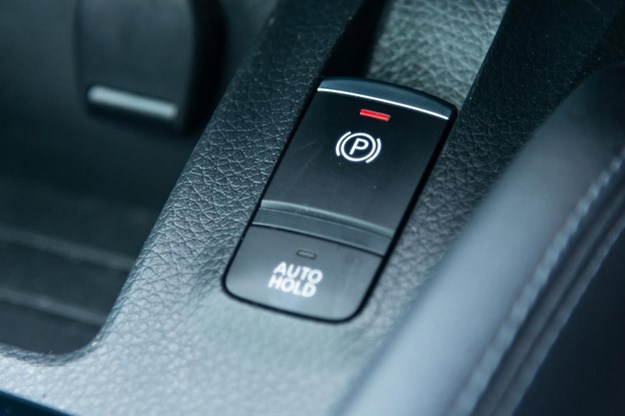
Regarding your list of gone but not forgotten technology: The dipswitch on a Series 2A Land Rover made a great foot rest. I fitted one to a later car for driving lights.
Have you priced an electric handbrake lately? Try $2500 for a common one. So much easier than a lever too. Lol.
Your circumference item: As you probably said, circumference = Pi x D, hence the incremental difference: Pi = Pi x (d1 – d2). But in issue 436, it says 20mm extra diameter is worth 628mm in circumference. Right numbers, wrong decimal point. 3.14 x 20 = 62.8mm.
Have an interesting day.
Andrew D,
Email
HI ANDREW, you’re not the first person to point out the error in the decimal point location. Normally, I’d just assume (accurately) that I’d just cocked up – again – and plead mea culpa. But this time I was so sure I’d been careful with the figures, that I went back and checked the original copy I wrote. And, yep, I was right, so the error has crept in somewhere along the production line (Many pairs of eyes see my copy before it’s printed. Mainly for legal purposes). Anyway, apologies for the goof, but it seems like everybody gets the point or the brain-teaser, so that’s the main thing. Since I love the idea of a floor-mounted dip-switch, I reckon a floor-mounted driving-light switch would be an excellent thing, too. And I honestly had no idea that a replacement electronic park-brake assembly was so damn expensive. Give it a few years, and cars will be getting written off because the cost to repair the hand-brake will be more than they’re worth. At which point I think we can all agree, the world has finally gone crazy.
Speaking of which, as I write this, the country is in the grip of a bog-roll hoarding frenzy as the Cressida Virus (it turned out to be bigger than the Corona) latches on, with people pulling knives on each other to claim a 24-pack. Who’d have thought World War 3 would eventually be fought over poo-tickets?
Lex-tech
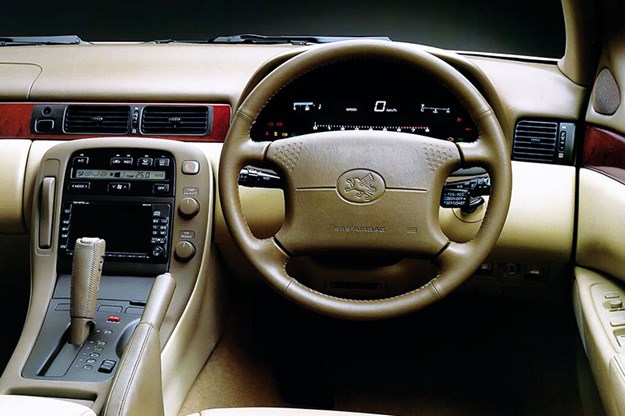
Lexus electric dash can be affordably repaired
G’day Morley. I’ve just read the article about a Lexus with electronic dash failure. When I was in the electronics business (now retired) I repaired a couple of Lexus electronic dashes. They had surface mounted electrolytic capacitors that had dried out and failed.
When they fail, the electrolyte leaks out and starts to corrode the PCB. The capacitors must be removed and the PCB carefully flushed with water or suitable solvent to dissolve the electrolyte and clean the board. After the PCB has dried, new Tantalum type surface mount capacitors of the same value can be soldered in place, observing the correct polarity.
The plugs and sockets can also be intermittent because of minor corrosion of the contacts. A ‘wipe’ of WD40 solves this problem. Both car dashes were working perfectly at least two years after I did the repairs.
The problem of failed electrolytic capacitors was widespread in the electronics industry and affected all manner of equipment. Most electronic workshops should be able to do the repairs. Any competent person who can solder should also be able to do the repairs.
Be careful to observe the polarity markings of Tantalum capacitors. They can burn up the PCB if installed incorrectly.
Failed electrolytic capacitors are not restricted to dashes. They are fitted to most electronics. Hope this info is of some benefit to keep car electronics serviceable.
Graham Lucke,
Bundaberg, QLD
I TAKE IT that observing the polarity of the capacitors is a bit like the scene from Ghostbusters where Harold Ramis reminds the other boys that it would be `bad’ to cross the streams from their (unlicensed) nuclear accelerators.
And thanks for the info, Graham, it might just make a big difference in keeping otherwise fantastic old Lexuses on the black-top.
The process of corrosion in circuit boards reminds me of older BMWs which had the service indicator (a row of little LEDS) built into the dashboard. Apparently, to keep track of the car’s service requirements if and when the car’s main battery was disconnected, these service indicators were backed up by a AA battery which mounted at the top of the printed circuit board.
Inevitably, when the AA died, acid leaked out of it and ran right down the length of the circuit board, destroying the circuit in the process. My BMW fixing mates reckoned it was the world’s most expensive AA battery change.
And again

Not born for the track despite the driver’s getup
Thanks for your great page in Unique Cars. I often want to write in but know I would waffle on about too many things. Is it possible for you to send this on to Nigel Dunlop re his email to you in the February 6 edition about the LS400 gauges?
I have a late 1994 LS400 and it is an astonishing car. I’ve had it for six years and as much as I like to vary cars, I can never quite convince myself to sell such a smooth and unbreakable bit of engineering for the $4000 or so I’d get for it (no matter how hard I tried). Mine has 276,000km and as far as non-service items go, in the past five years/70,000km I had to do the rocker cover gaskets because of leaks and chose to do the engine and transmission mounts to end a slight vibration. Thats it.
It has a slight leak from the power steering which would cost $2500 to fix, but I just top it up every three to six months (it’s now a 3000-5000km-a-year car). It has never had a breakdown except due to the battery failing.
I can’t help with Nigel’s temp gauge but on my LS400, the tacho sticks. After a lot of research on US sites I understand that there is a bit of ‘gloop’ behind the dial on the rear of the tacho. One site said the gloop was some type of lube that, with age, congeals in cool weather to be very hard then softens in the heat, when it becomes very sticky. One post said this also happens to the speedo sometime after the tacho, but mine is still OK.
When the heated-up car stops, the back of the needle/spindle (or whatever) settles into the gloop. When the car stops and cools down overnight the gloop hardens, sticking the needle in place. It can’t move until it heats up again and softens. Unfortunately I looked at this a few years ago and am no longer sure about the sites I read this on, but none have had a photo or more detailed description than what I’ve given anyway.
I haven’t yet tried to fix mine as it is intermittent and non-essential, but everything about its behaviour suggests this explanation is very likely (ie rarely sticks in cold weather; driving over cats eyes will free it, but only if the car has been in the heat for quite a while etc etc). Unlike Nigel’s mine doesn’t free with a tap unless the car has been in the sun for a long time.
According to the web this is a low-tech repair (remove/replace the gloopy stuff) that anyone can do if they can get to the back of the gauges. Being a mechanical nincompoop I haven’t tried, but may get a mechanic or sparky to tell me what such an operation would cost if the speedo goes the same way. Of course, I can’t guarantee any of this, but it seems to fit the pattern of my tacho behaviour perfectly. There is an online tutorial of removing the panel on a 90-94 model if you are game, see the page here.
A couple of tips for Nigel: I replaced my top quality, but hardened 12 year old tyres with Michelin Primacy 5s and the ride and wet-weather grip improved way beyond my expectations - LS400s are obviously tyre sensitive. Another little hint; check the AC filter. I convinced myself I needed a re-gas until I looked at the totally clogged filter which may never have been changed - air is like new after that. Hope this helps.
Trevor Hislop,
Email
TREVOR, DON’T ever be afraid to contribute to this column on the basis that you like to ramble a bit. We’re all guilty of the same thing and, I have to say, your description of the problem and potential fix is anything but a ramble. I’m also going to recommend to the people at the Macquarie Dictionary that `gloop’ gets a guernsey in the next edition.
It’s interesting that the one question has elicited two very different answers (one electronic, the other gloop related) and I reckon that just reflects how complex and intricate relatively modern cars like a Lexus LS400 really are.
But you could well be on to something, and I’ll tell you why: Years ago, my brother-in-law had a Datsun 200B (yeah, I know, but you haven’t met the bloke). Anyway, every now and then, he’d go to work and come out in the afternoon to a car with a totally flat battery.

I wonder if any owner asked the question, more what?
At first he noticed that it only happened in the warmer months. Fair enough. Then he also (and don’t ask me what clicked in his head this time) noticed that the problem only occurred when he parked the car facing east. Turns out, the headlight flasher switch was old and worn. It was lubricated in grease that, when the temperature was low enough, stayed viscous enough to hold the switch off its contacts. But when the temp inside the car rose (such as when the afternoon sun from the west in the warmer months) hit the steering column through the rear window, the grease became fluid enough to let the flasher stalk drop down into the flash position. At which the high-beams came on and flattened the battery, Spooky, huh?
You couldn’t make it up, but it gives your gloop theory some real legs, I reckon.
Piston confused
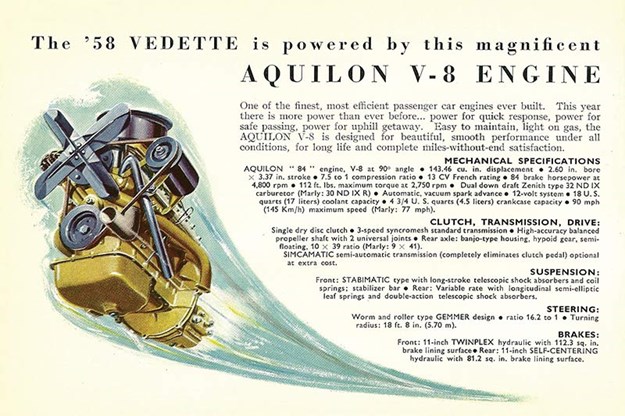
Simca shoehorned a V8 into the Vedette
Dave, I read with interest your story in issue 436 regarding weird combos of pistons. In the early 60’s, I had a 50’s Simca Vedette with the V8-60 engine. While driving up Browns Mountain (NSW) in extreme heat, the top of one of the pistons decided it had had enough and let go. The car was transported to Nimmitabel for repair.
There were not a lot of these cars on the road and spare parts were not plentiful, and so after four days looking for a piston, the mechanic improvised and used one Norton motorbike piston and rings. I drove the car for a further 12 months with no problems. You have to love and admire the old bush mechanics.
Allen Bridges,
Email
A SIMCA VEDETTE! Now there’s a car you don’t hear about often enough. As far as mixing and matching pistons goes, I guess as long as the pin-height is right, the bore is right and the crown doesn’t interfere with the valves, it kind of should work. I love the fact that you continued to drive it for another year, too. And I bet whoever owned it after you was none the wiser about the chequered past of one piston.
TRIVIAL PURSUIT
Trip up

Apparently, the US mob making Centerline Wheels went belly-up a couple of years ago. Frankly, the classic, solid-disc Centerline was never my cup of tea, but it’s an interesting story on why they were designed the way they were. Apparently, in the early days of timing beams at dragstrips, the spidery, spoked front wheels of the day didn’t always trip the beam. But the Centreline, with its solid profile was a wheel even the dimmest beam couldn’t fail to spot.
Sad ending

Some of you will know that a bloke named Cecil Kimber was the brains behind and co-founder of the company that eventually became MG. But what you mightn’t know is how Cecil went to his reward. On February 4, 1945, he boarded a train in London, heading to Leeds. But the train stalled on a slippery section of new track, began to roll backwards and derailed at a set of points. Cecil and one other passenger, who was also in the carriage that was crushed against the signal gantry, died.
Write to Morley c/ouniquecars@primecreative.com.auor Unique Cars magazine, 379 Docklands Drive, Docklands, Victoria 3008
Unique Cars magazine Value Guides
Sell your car for free right here
Get your monthly fix of news, reviews and stories on the greatest cars and minds in the automotive world.
Subscribe

.jpg)







